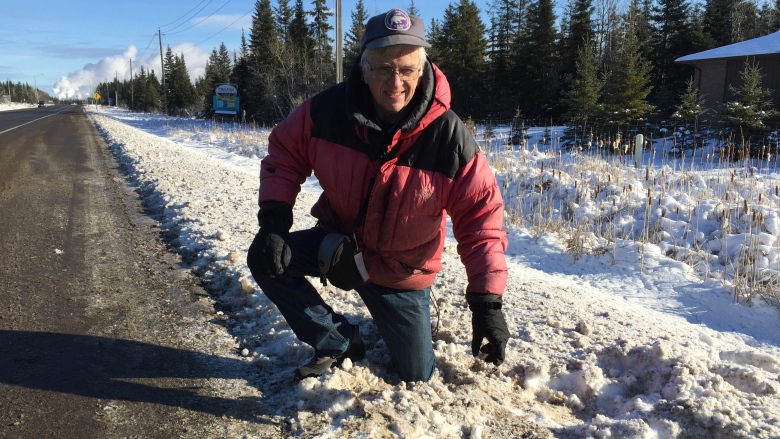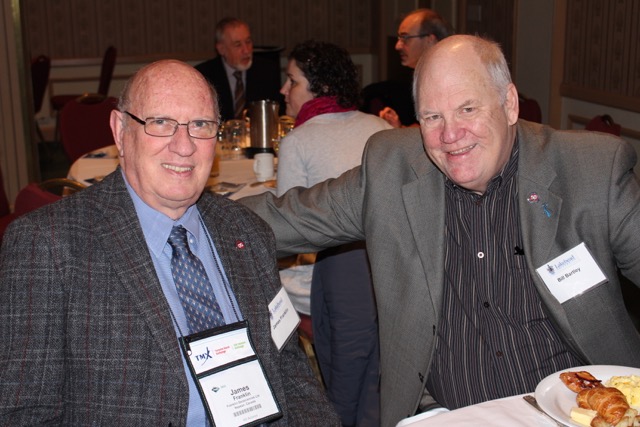A geologist with Lakehead University is hopeful fragments collected from a crater near Highway 61 are from a meteorite, but definitive answers are not available just yet. TBNewsWatch Doug Diaczuk
Dec. 18 THUNDER BAY - What fell from the sky last week on the city’s south side near Highway 61 still remains a mystery, but a geologist at Lakehead University said a lot of the signs do point to a possible meteorite strike. Stephen Kissin, a geology professor at Lakehead University, has been examining small fragments recovered from the site of what could be a meteorite striking the ground on Highway 61 near Mount Forest Boulevard. “It is a little problematic because the site was dirty and there were old pieces of asphalt in it as well, and they are all dirty, so it’s difficult to tell just by quick looks exactly what’s there,” Kissin said. The strike occurred last Wednesday at approximately 11 p.m. during the Geminid Meteor Shower. Residents in the area contacted police after reportedly hearing a loud explosion that shook nearby houses. A small crater was found on the side of the highway by police who were investigating the incident. Kissin said it is looking hopeful that fragments recovered are in fact from a meteorite, but it cannot be conclusively determined until the fragments are cleaned and examined using an electron microscope. According to Kissin, meteorites are identified by the internal structure, and not the shape, as many people believe. “There are three kinds of meteorites,” Kissin said. “Iron meteorites, stony meteorites, which this likely is, and the most common kind are chondrites, they have tiny little round structures in them called chondrules.” Kissin compared this possible strike to an airburst that happened over Quebec in June, 1994. The St. Robert Meteorite was seen over Montreal and left behind several large fragments over a seven kilometer area, or ellipse. If the strike in Thunder Bay was similar, it may have left behind other larger fragments that just haven’t been found yet. “It certainly seems there would be larger fragments, if they made it to earth,” Kissin said. “That’s another problem. So much of the earth is covered by water anyway, so if they land in water, that’s the end of the story. But it was almost certainly larger than what we saw here because of the loud detonation and the shockwaves people reported.” Kissin said it still remains an open question regarding exactly what caused the crater and explosion last Friday based on the samples collected. But he hopes to have more definitive answers in the coming weeks as the samples undergo further testing. He is also still interested in hearing any further eyewitness accounts of the strike. So far, only one person has come forward claiming to have seen the flash of light. “I would be interested in hearing from anyone who did see it,” Kissin said. “It was, however, over a sparsely populated area and late at night, and a cold night as well, so perhaps people weren’t about.”
Please scroll 5:37 into this TBTV video for the story:
https://www.tbnewswatch.com/video/tbt-newshour/december-18-2017-levesque-trial-video-794491
Did a meteorite impact near Thunder Bay Wednesday night?
Weather Network Friday, December 15, 2017
Police in Thunder Bay are reporting a possible meteorite crash near the city on Wednesday night. Based on what's missing from the story, is that really what happened, though? Here's what we know. At roughly 11 p.m. on Wednesday night, officers from the Thunder Bay Police Service were dispatched to investigate reports of an explosion, just to the southwest of the city. According to a Police Service press release, upon searching the area, along Highway 61, near Mount Forest Road, the officers discovered "a large round hole in the snow on the side of the road approximately two and a half feet around." In the centre of the hole, they said, was a pile of a "rock like substance". The same hole, from a different angle, shows the size, and the depth of the crater. Credit: Thunder Bay Police Services No footprints or tire tracks were found in the vicinity of the hole, according to the Police statement, and based on images taken at the scene, the hole was located on the shoulder of the asphalt road. According to a report by CBC News, local resident Linda Pohole had called police after hearing an explosion. "I called it in thinking that something happened in Mount Forest, and maybe a house exploded," she told CBC News. "It was that loud, and my son said he felt the house vibrate." Dr. Stephen Kissin, Professor Emeritus from Lakehead University, examines a hole in the ground that some say was caused by a meteorite. The original material that police found in the middle of the crater appears to have been removed. Credit: Lakehead University Police Services contacted Lakehead University, and the following morning, Dr. Stephen Kissin, a Professor Emeritus from the university's geology department, was on the scene to investigate. However, upon arriving, he found no meteorite present in the hole. Presumably, the "rock like substance" went missing overnight. While there was some speculation that this may have been the result of the Geminid Meteor Shower, Dr. Kissin told CBC News that it was not likely, and that this was just a coincidence. What happens when a meteorite strikes the ground? Although tonnes of meteoroids are swept up by Earth's atmosphere every day, most of them are bits of dust or ice crystals, with the occasional larger piece of rock or ice. Any of the smaller meteoroids can create a brief flash of light in the sky, as they plunge into the atmosphere travelling at hundreds of thousands of kilometres per hour. The flash is produced as the air in the meteoroid's path is instantaneously compressed to the point where it glows, white hot. We had an excellent example of this over the past few days, due to the Tuesday night peak of the Geminid Meteor Shower. These small bits of matter are often vapourized by the hot, compressed air, however, and thus nothing survives to reach the ground. Larger meteoroids are much more noticeable as they enter the atmosphere. They are travelling just as fast as the smaller bits, and their larger mass compresses more air, causing an even brighter flash of light. This is usually called a "fireball". Some fireballs are so bright that they briefly light up the sky as if it were daytime, and a smaller subset can produce sonic booms. These meteoroids are far more likely to survive to reach the ground, often in pieces as they tend to break apart while they are still high up in the air. On their way to the ground, larger meteoroids will pass into their "dark flight" phase. This is when the meteoroid has been slowed down by its interaction with the atmosphere so much that it's no longer compressing the air to the point of incandescence, and the meteoroid simply become a rock falling at somewhere around terminal velocity towards the ground. It can still cover plenty of distance across the map during this time, as it takes a ballistic trajectory towards the ground. When it hits, it's called a meteorite. When it hits the ground, a dark flight meteoroid can still be travelling at around 500-600 km/h, so there's certainly the potential for it to produce a small crater. It's unlikely that the impact would cause an explosion, however. Any explosion, and resulting shaking of local residences, would result from the meteoroid breaking up, far above the ground. For example, on March 26, 2003, the city of Chicago was pelted by hundreds of meteorites. One 15 centimetre-wide, 2.7 kg specimen managed to punch through the roof of a house, and the kitchen floor as well, ending up in a laundry pile in the basement. It did not, however, produce an explosion that shook nearby houses. According to a report by the Meteoritical Society, it did, however, produce a bright fireball that was visible in parts of Illinois, Indiana, Wisconsin and Ohio. Was this a meteorite, or something else? Watch the video above, and you'll see a fairly good example of a bright fireball event. So, what's missing for this event in the Thunder Bay area is the bright flash that should have accompanied it. An object big enough to generate a sonic boom, which shakes houses on the ground in the vicinity, would have caused a very bright fireball, possibly even a bolide explosion. This is the kind of event where night suddenly turns into day for a brief moment, and this would have been clearly visible for hundreds of kilometres around. As of Friday, December 15, there have been no fireball reports from the Thunder Bay area for that night on the American Meteor Society website, which logs fireball reports from anywhere in the world. Since the skies in the area were reasonably clear that night, the chances of a bright fireball going unnoticed, especially with the city of Thunder Bay only a short distance away, are slim. Dr. Kissin is reportedly still examining the sample collected from the site, so no conclusions have yet been made. It will not be surprising, though, if something else - terrestrial and likely human-caused - is responsible for this event.
http://www.cbc.ca/beta/news/canada/thunder-bay/thunder-bay-meteor-1.4448359
Stephen Kissin, professor emeritus with Lakehead University's geology department, checks out an area alongside Highway 61 where police suspect a meteorite may have hit the ground. (Jeff Walters/CBC)




